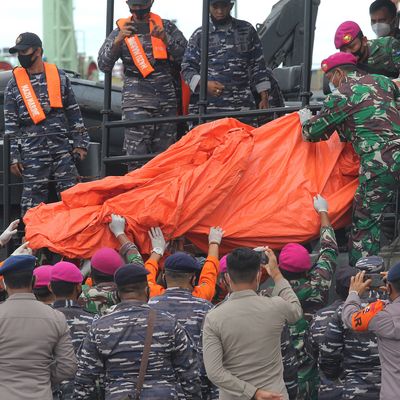
Authorities have located the black boxes for Sriwijaya Air Flight 182, the Boeing 737 that crashed Saturday in Indonesian waters after it plunged suddenly and precipitously four minutes after takeoff. The data they contain should clarify why the plane dove 10,000 feet nearly vertically in just 15 seconds and struck the Java Sea at nearly 500 miles per hour, instantly killing the 62 people aboard.
The speed of the descent implies that the plane remained substantially intact, with the engines generating power right until the end. No mayday call was transmitted, nor did the emergency beacon transmit after impact. The speed of the impact likely shredded all but the rearmost portions of the aircraft.
Sriwijaya Air, Indonesia’s third largest airline, was founded in 2003. Before Saturday it had lost three 737s in bad landings but these accidents had not killed any passengers or crew. In 2019, half of its aircraft were temporarily grounded by regulators for safety reasons. Indonesian airlines overall have a notoriously poor safety record. In the past decade, nearly 700 people have died in air crashes in the country.
The crash occurred exactly one month after Boeing’s 737 Max returned to service following a two-year grounding, precipitated by two deadly crashes. Last Thursday the U.S. Department of Justice announced that Boeing had been charged with fraud for misleading the FAA about the Max’s design flaws and had agreed to pay more than $2.5 billion. The airplane that crashed on Saturday was an older model and was not equipped with the faulty system cited in the 737 Max crashes.
Saturday’s flight from Jakarta to the city of Pontianak, 450 miles to the northeast, took off in the rain at 2.36 p.m. local time after a weather delay. According to Accuweather, thunderstorms were prevalent throughout the region all afternoon, and subsequent search-and-rescue efforts were hindered by heavy rain and winds.
According to the flight-tracking website Flightradar24, which collects flight information automatically transmitted by airliners, Sriwijaya Air Flight 182 took off to the southwest and made a gradual turn to the right as it climbed. At 2:39:40, the flight crossed the coast and headed out over the ocean. Twenty seconds later, for reasons unknown, it began a shallow turn to the left, and slowly started to lose altitude. By 2:40:12 the plane was nosing into a rapidly accelerating vertical dive that could only have been intensely terrifying for those onboard. In its final 15 seconds, the aircraft’s speed climbed from 320 to 495 mph, substantially faster than the 737 is designed to fly.
The automatically transmitted data made it easy to find the aircraft’s wreckage, which had come to rest in shallow water near the coast. In 2014, after AirAsia Flight 8501 crashed about 50 miles off the coast of Borneo, authorities took more than two weeks to locate the main wreckage.
It’s rare for a commercial jet to abruptly enter a high-speed terminal dive. In 2016, a West Air Sweden CRJ cargo jet dove into the ground in northern Sweden after a faulty navigation computer caused its pilots to become disoriented. In 1997, a SilkAir 737 en route from Jakarta to Singapore suddenly entered a steep dive from 35,000 feet in what U.S. investigators deemed a likely case of pilot suicide. In November 2001, an American Airlines Airbus A300 plunged into the Rockaway peninsula three minutes after takeoff from New York’s JFK airport after the pilot’s misapplication of the rudder controls caused part of the tail to rip off.
So far there’s no reason to think that any of the factors behind those crashes were at play in Saturday’s mishap. The data from the black boxes should establish what happened, but it could take months before the findings are released to the public. In the case of AirAsia 8501, Indonesian investigators only issued their report to the public 11 months after the plane disappeared.






























